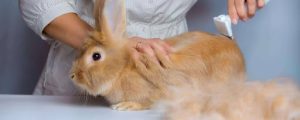Winter brings unique challenges to rabbit grooming. As temperatures drop, it becomes crucial to adapt your grooming routine to ensure your rabbit remains healthy, comfortable, and well-cared for. This guide provides essential tips and best practices for grooming your rabbit during the winter months.
- Understanding Seasonal Changes in Fur
During winter, rabbits typically grow a thicker coat to help insulate them against the cold. This seasonal change means that their grooming needs will be different compared to other times of the year. You can refer to this article on how to groom a rabbit easily by Bunny Vault for further reading,
- Thicker Fur: The denser winter coat requires more frequent brushing to prevent mats and tangles.
- Shedding Patterns: Some rabbits may still shed during winter, necessitating regular grooming to manage loose fur.
- Brushing and Fur Maintenance
Regular brushing is crucial in winter to keep your rabbit’s fur in top condition.
- Choose the Right Brush: Use a slicker brush for long-haired breeds and a bristle brush for short-haired breeds. A metal comb can help remove tangles and mats.
- Increase Frequency: Brush your rabbit at least twice a week to remove loose fur and prevent matting. Long-haired breeds may require daily brushing.
- Gentle Handling: Be gentle when brushing to avoid damaging the delicate skin beneath the thick fur.
- Dealing with Mats and Tangles
Mats and tangles can be more common in winter due to the thicker coat.
- Regular Inspections: Check your rabbit’s fur for mats and tangles, especially around the neck, under the belly, and in the hindquarters.
- Careful Removal: Use a mat splitter or your fingers to gently tease out small mats. For larger mats, consider using a pair of blunt-nosed scissors to carefully cut them out, being cautious not to cut the skin.
- Preventative Brushing: Regular, thorough brushing can help prevent mats from forming in the first place.
- Nail Trimming
Rabbits’ nails continue to grow throughout the year and should be trimmed regularly, even in winter.
- Routine Checks: Inspect your rabbit’s nails every few weeks to determine if they need trimming.
- Proper Tools: Use nail clippers designed for small animals to ensure a clean cut. Avoid cutting too close to the quick, which can cause bleeding and pain.
- Comfort and Safety: Ensure your rabbit is comfortable and secure during nail trimming to minimize stress and prevent injuries.

- Ear and Eye Care
Winter can bring additional concerns regarding ear and eye health.
- Inspect Ears: Check your rabbit’s ears for signs of wax buildup, dirt, or infection. Gently clean the outer ear with a damp cloth if necessary.
- Eye Monitoring: Look for signs of eye discharge, redness, or irritation. Clean around the eyes with a soft, damp cloth if needed.
- Bathing Considerations
Bathing rabbits is generally not recommended, as it can be stressful and potentially dangerous. This is especially true in winter, when wet fur can lead to chills and hypothermia.
- Dry Bathing: If your rabbit’s fur becomes soiled, use a damp cloth to spot-clean the affected area. Dry bathing powders designed for rabbits can also be used to absorb excess oils and dirt.
- Avoid Full Baths: Full baths should be avoided unless absolutely necessary and under the guidance of a veterinarian.
- Maintaining a Warm Environment
Ensuring your rabbit stays warm and dry is crucial during winter.
- Indoor Housing: Keep your rabbit indoors in a warm, draft-free area. Avoid placing their enclosure near windows or doors where cold drafts can enter.
- Bedding: Provide plenty of soft, insulating bedding such as hay, straw, or fleece blankets. This will help keep your rabbit warm and comfortable.
- Hydration: Ensure your rabbit has access to fresh water at all times. Check water bottles frequently to ensure they haven’t frozen.
- Diet and Hydration
Proper nutrition and hydration are essential for maintaining your rabbit’s health during winter.
- Balanced Diet: Provide a balanced diet rich in hay, fresh vegetables, and high-quality rabbit pellets. Hay is particularly important for digestive health and warmth.
- Fresh Water: Ensure your rabbit has constant access to fresh water. Use a water bottle cover or a heated water bowl to prevent freezing.
Grooming a rabbit in winter requires extra care and attention to address the unique challenges posed by colder weather. By adapting your grooming routine to include regular brushing, nail trimming, ear and eye care, and ensuring a warm, safe environment, you can keep your rabbit healthy, comfortable, and happy throughout the winter months. Remember, a well-groomed rabbit is better equipped to handle the seasonal changes, making grooming an essential part of winter care.
Reference: Bunny Vault
